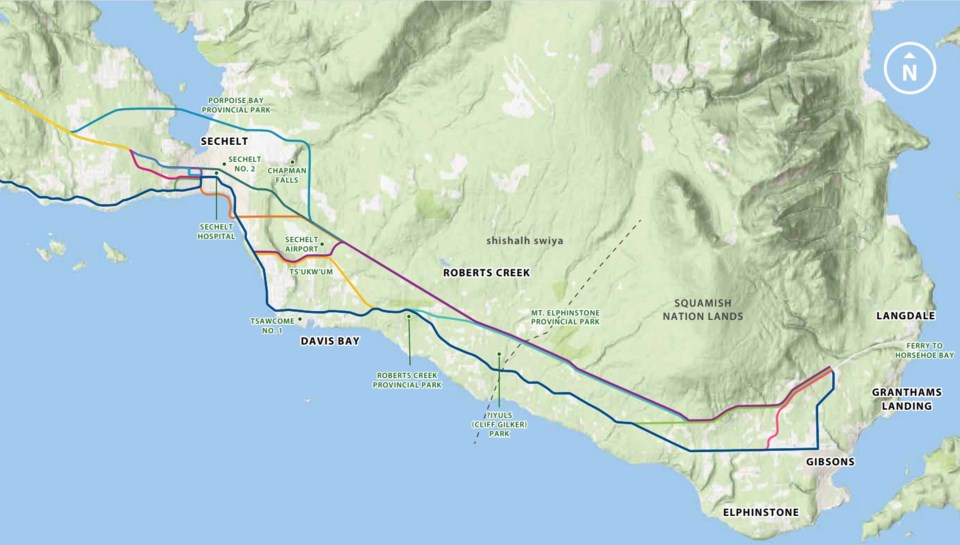A Highway 101 bypass of 3.3 kilometres from Stewart to Payne Road, re-routing the highway around Gibsons, is the recommendation of the final report on the Highway 101 Alternate Route Planning Study. It is also the only change to the highway route recommended.
The report, issued by the Ministry of Transportation and Transit (MOTT) and shíshálh Nation three years after the study launched, examines the section of highway between Gibsons and Trout Lake.
A Gibsons bypass was ranked higher than making improvements within the existing highway corridor in the study area. It also outranked two other possible bypasses. One of those, from Hilltop to Havies Road in Sechelt's Davis Bay area, would have added a second vehicle crossing over Chapman Creek, providing an alternative should the aging bridge over the waterway be compromised. The other, using portions of Sechelt’s Dolphin and Trail Avenues and the BC Hydro right-of-way, would have skirted the highway around the downtown commercial portion of that jurisdiction.
'Clear timeline and a firm commitment' needed: Gibsons Mayor
Crucially re-routing traffic around Gibsons, that bypass, “Is the preferred long-term route to meet the study objective of a clear, long-term plan to account for growth in the region with considerations for enhanced safety, network redundancy, climate change resiliency and accommodation for active transportation and transit," said the report.
Gibsons Mayor Silas White says the option appears "feasible and accessible." The bypass addresses some of the community's key concerns, said White in an email, "particularly the growing need to reduce congestion and improve safety through our Town Centre, especially at the busy North Road and School Road intersection."
But, follow through is key. "While we support this direction, what we need now is to see a clear timeline and a firm commitment to move this project forward," said White.
The other two potential bypass candidates faced construction costs and socio-economic considerations that led to lower rankings and the report not recommending their fruition.
Sunshine Coast Regional District Board Chair Alton Toth said the board was "unsurprised that the majority of the alternate routes and bypass segments were found to be unfeasible" but that it acknowledges that there are sections of the highway "in critical need of improvements, not just for our drivers, but also for our active transportation users as well."
“We will continue to advocate to MOTT for additional improvements for safety, such as the new crosswalk at Woodcreek Park and the new intersection at Shorncliffe," wrote Toth in an email.
As for a second Chapman Creek crossing (via a highway or a secondary road), Sechelt Mayor John Henderson said that it is a definite “need." He said he was not personally in favour of the Hilltop to Havies Road bypass option, rather, an additional crossing is more of a safety and emergency preparedness thing than a highway consideration.
Current highway can meet demands up to 2050
The study also found that the current highway capacity can meet demands up to 2050, even with higher than anticipated population growth.
“Vehicle demand is expected to grow between 1.7% and 2.8% per year, meaning that peak hour volumes would reach up to only 1,700 vehicles in the busiest portion of the highway (Roberts Creek to Sechelt) by 2050, whereas the theoretical capacity of Highway 101 is more than 1,800-1,900 vehicles per hour. Peak hour vehicle volumes in other sections of the corridor are much lower than in Roberts Creek,” the report's executive summary explains.
For Henderson, the worst issues of highway congestion “have always been West Sechelt, through downtown to Selma Park and Davis Bay and onto Wilson Creek," he said. "It doesn’t seem to me that this report is addressing any of those real choke points.
"They are transportation professionals, so I am not about to challenge their professional view, but seeing a [traffic] lineup trying to turn left at Wharf and Dolphin lined up past the Tsain-Ko mall, it’s hard to imagine the highway meets peak demands.
"We have a lot of time that road is very low [traffic] volume, but you can’t plan for the average; you have to plan for the peaks. I can’t see that the assessment that they are making that 2050 is viable."
Questioning study results
Elphinstone resident Richard (Buzz) Bennett’s assessment of the report is different. He says the report was “a waste of taxpayer money and this from a Ministry whose oft-stated mantra is 'safety is our first concern.'"
The report, he stated, “is a masterpiece of bureaucratic bafflegab and obfuscation specifically designed to hide the fact that there is no political will to spend the money to build a bypass highway."
Bennett is also a member of the Sunshine Coast Highway Society, which has been advocating for a new “state of the art” highway from Langdale to Sechelt and beyond for the past six years, according to its website, which notes that “previous organizations had also pursued this for many years before."
"A real highway will improve the quality of life for everyone, but this report doesn't address that," Henderson said.
Back in 2022, the highway society, all lower Sunshine Coast local governments and the community at large were invited to be part of a two-month public engagement period on highway routing alternatives. The responsible parties received the results of that process in May 2023.
The full report is posted on the ministry’s website along with background info on the study process.
Words missing in article? Your adblocker might be preventing hyperlinked text from appearing.



